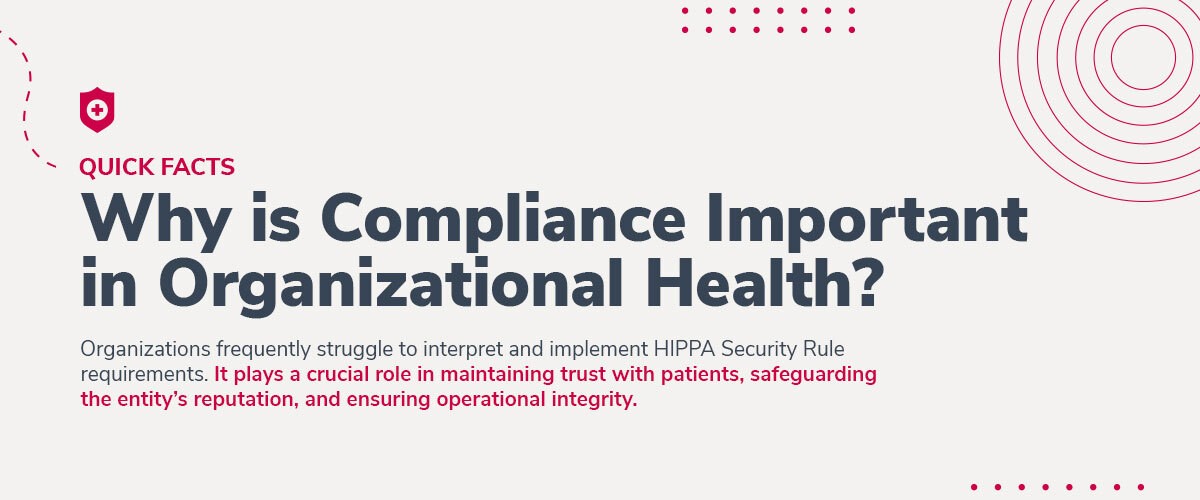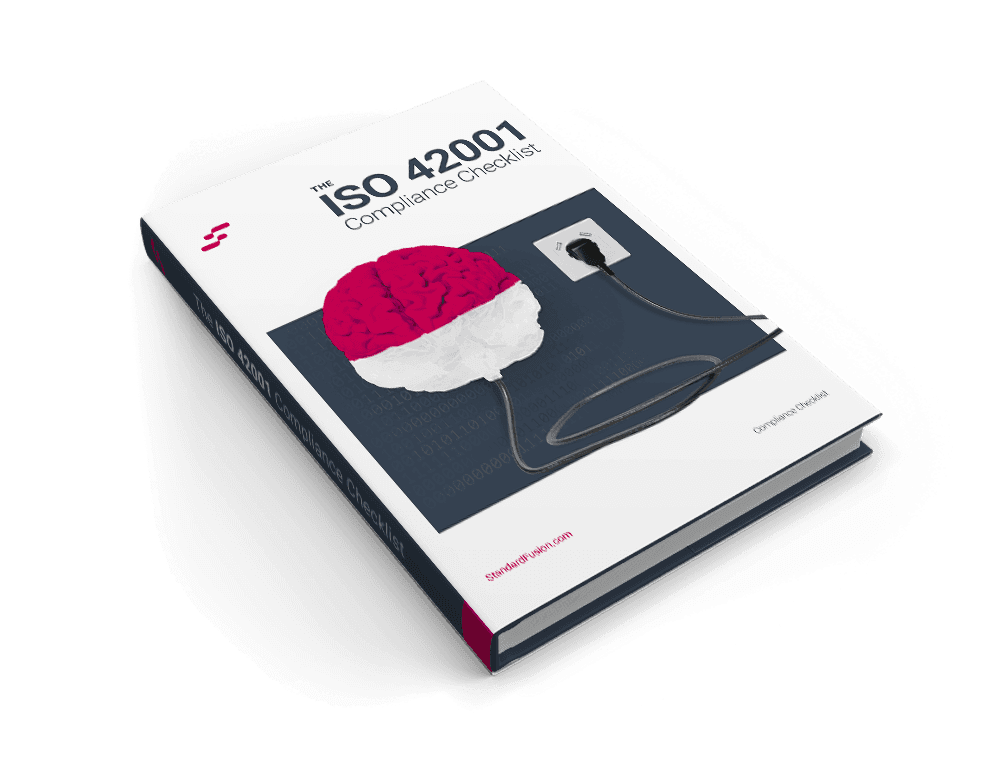Published on: Apr 18, 2019
| Updated: Apr 1, 2025
The Definitive Guide to the HIPAA Security Rule: Balancing Technology and Privacy
In this article, you'll learn the crucial components of the HIPAA Security Rule, the challenges healthcare organizations face, the best practices for effective compliance, and the role of artificial intelligence in HIPAA compliance.
Finally, you will also understand the impact of HIPAA on building patient trust and maintaining the health of healthcare organizations.
The Healthcare Industry and HIPAA
In today's highly digitalized era, the healthcare sector faces significant challenges and responsibilities. The shift towards digitalizing patient records and medical data has increased the need for stringent security measures.
This transition to digital healthcare offers benefits in terms of efficiency and accessibility. However, it also raises serious concerns about the safety and privacy of patient information.
At the heart of addressing these concerns is the Health Insurance Portability and Accountability Act (HIPAA). This pivotal legislation sets rigorous standards for protecting patient information, also known as protected health information (PHI).
HIPAA's rules are designed to ensure that PHI is not only kept confidential and secure but also readily accessible when necessary for patient care.
A Definition of HIPAA Compliance
HIPAA was established to modernize the following:
The flow of healthcare information
To stipulate how personally identifiable information maintained by the healthcare and healthcare insurance industries should be protected from fraud and theft
Address limitations on healthcare insurance coverage.
Also, it's important to understand that compliance is multifaceted, involving several rules:
The Privacy Rule: Protects the privacy of individually identifiable health information.
The Security Rule: which sets standards for the security of electronic protected health information (ePHI).
The Enforcement Rule: which contains provisions relating to compliance and investigations, and the imposition of civil money penalties for failing to comply with HIPAA standards.
The Breach Notification Rule: which requires covered entities to notify affected individuals, U.S. Department of Health & Human Services (HHS), and, in some cases, the media of a breach of unsecured PHI.
The Need for HIPAA Compliance
The need for HIPAA compliance has never been more critical. The reason? Well, healthcare providers and associated businesses increasingly adopt electronic systems to create, store, and manage patient health information. All these increase the potential for data breaches.
Compliance ensures that all parties involved in the healthcare process use standardized mechanisms for PHI transactions. Furthermore, the goal is to reduce the likelihood of data breaches and improve the quality and coordination of patient care.
HIPAA compliance helps to:
Protect sensitive patient information from unauthorized access or disclosure.
Enhance patient trust, as they can be confident their personal health information is secure.
Avoid legal consequences and financial penalties associated with non-compliance.
Promote a culture of accountability and transparency within healthcare organizations.
Let's talk about the HIPAA Security Rule next.
What is the HIPAA Security Rule?
The Health Insurance Portability and Accountability Act (HIPAA) Security Rule does not operate in isolation but is closely linked with the HIPAA Privacy Rule and the Breach Notification Rule. The Privacy Rule sets out standards for protecting individuals' medical records and other personal health information. This applies to:
Health plans
Healthcare clearinghouses, and
Healthcare providers that conduct certain healthcare transactions electronically.
While the Privacy Rule focuses on the rights of patients to control their personal health information (PHI), it covers all formats, including electronic, paper, and oral. This rule establishes who may have access to PHI, ensuring the confidentiality and security of such information.
In contrast, the HIPAA Security Rule specifically deals with the protection of electronic PHI (ePHI). Covered entities (CEs) must implement adequate safeguards that are physical, technical, and administrative in nature. These measures protect patient ePHI during electronic transactions, such as when sharing data via email or storing information on the cloud.
Understanding these distinctions is crucial for compliance, as each rule serves a unique role in safeguarding patient information. While the Privacy Rule provides a broad framework for all PHI, the Security Rule zeroes in on electronic data protection, ensuring a comprehensive approach to healthcare privacy and security.
Understanding the Three Standards of the HIPAA Security Rule
To properly safeguard patient data, the HIPAA Security Rule outlines three critical standards: administrative, physical, and technical safeguards. Each plays a crucial role in ensuring the protection of electronic protected health information (ePHI).
Administrative Safeguards: The Management Aspect
These involve designing and implementing policies that govern the management of security measures. They ensure that a healthcare entity's workforce operates in compliance with privacy rules when dealing with ePHI. Key components include:
Risk Analysis: Identifying potential vulnerabilities in data handling processes.
Employee Training: Educating staff about privacy protocols and security practices.
Security Policies: Establishing comprehensive guidelines for data protection.
Business Associate Agreements: Creating formal arrangements with partners that handle sensitive data.
Physical Safeguards: Protecting Electronic Systems, Buildings, and Equipment
Physical safeguards focus on the protection of the physical environment and equipment that store ePHI. This includes:
Facility Access Controls: Implementing measures to prevent unauthorized entry to areas housing critical information.
Workstation Use Policies: Defining how workstations, such as computers and laptops, should be used to ensure security.
Workstation Security: Putting measures in place to secure physical devices from unauthorized access.
Device and Media Controls: Managing the entry and exit of devices and media that may contain sensitive data.
Technical Safeguards: Technology and Policy Protections for ePHI
Technical safeguards concern the technology and the policy and procedures for its use that protect ePHI and control access to it. They include:
Access Control: Implementing technical policies and procedures that allow only authorized persons to access ePHI.
Audit Controls: Implementing hardware, software, and procedural mechanisms to record and examine activity in information systems containing ePHI.
Integrity Controls: Implementing policies and procedures to ensure ePHI is not improperly altered or destroyed.
Transmission Security: Implementing technical security measures that guard against unauthorized access to ePHI that is being transmitted over an electronic network.
To effectively implement these safeguards following a risk assessment, it is essential to adopt a data-centric security approach. This modern methodology extends beyond traditional perimeter-based protections to focus on securing the data itself.
How Data-Centric Security Aligns with HIPAA's Technical safeguards
Data-centric security seamlessly integrates with the HIPAA Security Rule's technical safeguards by ensuring that sensitive information, such as Protected Health Information (PHI), is consistently protected no matter where it travels. Here’s how it aligns:
Access Controls:
Data-centric security provides robust access management, ensuring that only authorized individuals can view or modify PHI. This aligns with HIPAA's requirement for strict access controls to protect sensitive data.
Transmission Security:
By implementing encryption and secure transmission policies, data-centric security protects PHI as it moves across networks. This addresses HIPAA's mandate for safeguarding data during electronic transmission, guarding against unauthorized access or interception.
Audit Controls:
It offers enhanced visibility and monitoring capabilities, documenting who accesses the data, the time, location, and the methods used. This persistent monitoring satisfies HIPAA's need for audit controls, ensuring compliance by tracking access and modifications to sensitive data.
By following these principles, data-centric security ensures a comprehensive approach that aligns with and strengthens the technical safeguards required by HIPAA. This strategic alignment not only ensures compliance but also builds trust in how sensitive information is managed and protected.
How do you identify and implement safeguards though? Let's check that out.
Risk Analysis and Management: An Ongoing Process
Conducting a risk analysis is the first step in identifying and implementing safeguards that comply with and carry out the standards and implementation specifications of the Security Rule.
This involves:
Data Collection: Identifying where the ePHI is stored, received, maintained, or transmitted. Understanding the flow of patient data throughout your organization is crucial.
Identify and Document Potential Threats and Vulnerabilities: Determining all the ways that ePHI could be compromised. This includes recognizing weak passwords or lack of office security policies.
Assess Current Security Measures: Reviewing current measures used to safeguard ePHI, ensuring they align with HIPAA's technical safeguards. This step is vital for understanding how well your existing practices protect patient data.
Determine the Likelihood of Threat Occurrence: Taking into account the potential impacts and the likelihood of occurrence for each identified threat. This includes assessing both internal and external risks.
Determine the Potential Impact of Threat Occurrence: Assessing the possible outcomes of a breach in security. Prioritizing risks based on their impact helps focus resources effectively.
Determine the Level of Risk: Analyzing the measures in place and determining their effectiveness. Start by addressing the highest risk items, such as ensuring email encryption.
Finalize Documentation: Ensuring all findings and actions taken are documented. Documentation is essential for audits and demonstrates a proactive approach to risk management.
Once the risk analysis is complete, healthcare organizations should implement data-centric security strategies that go beyond traditional network protections. These strategies include:
Data Control: Applying persistent security policies to PHI, regardless of its location or the devices used.
Intelligence Gathering: Maintaining real-time visibility over who accesses data, when, and how, to enable effective threat monitoring and incident response.
By integrating these advanced security measures and maintaining comprehensive documentation, healthcare organizations can protect patient data more effectively and ensure ongoing HIPAA compliance.
HIPAA Security Rule and Its Relationship with Other Regulations
The HIPAA Security Rule does not operate in isolation but is closely linked with the HIPAA Privacy Rule and the Breach Notification Rule. The Privacy Rule sets out standards for protecting individuals' medical records and other personal health information. This applies to:
Health plans
Healthcare clearinghouses, and
Healthcare providers that conduct certain healthcare transactions electronically.
The Breach Notification Rule requires covered entities and business associates to provide notification following a breach of unsecured PHI.
The Role of Compliance in Organizational Health
Compliance with the HIPAA Security Rule is not merely a legal requirement, it also plays a crucial role in maintaining trust with patients, safeguarding the entity's reputation, and ensuring operational integrity.
Above all, a robust compliance program demonstrates a commitment to protecting sensitive patient data and can be a competitive advantage in the healthcare industry.

Challenges and Best Practices for Security Rule Compliance
Organizations often face challenges in interpreting the Security Rule's requirements, translating them into actionable policies, and continually monitoring their compliance posture. Additionally, best practices suggest that entities should adopt a proactive approach to compliance.
The goal is to seek out tools and technologies that can simplify the compliance process, and engage in continuous education on HIPAA requirements and industry trends.
Key Steps to Enhance Security Posture
Conduct a Comprehensive Risk Assessment
Begin by scheduling an internal risk assessment annually. This crucial step helps you understand how electronic Protected Health Information (ePHI) and Protected Health Information (PHI) might be at risk. By identifying the flow of PHI within your organization, you can pinpoint vulnerabilities and threats. This proactive approach aids in preventing data breaches, fines, and penalties.
Identify and Mitigate Risks
Once you've mapped out how PHI is managed, assess vulnerabilities like weak passwords or lack of office security policies. Determine the risk level by analyzing the likelihood and potential impact of these vulnerabilities using a risk matrix. Prioritize high-risk areas and implement security measures, such as additional encryption for email communications.
Implement Technical Safeguards
Embrace data-centric security, which aligns with the HIPAA Security Rule’s technical safeguards. This involves applying persistent security policies and maintaining real-time visibility over who can access data. Such safeguards ensure that PHI remains protected, enhancing both compliance and patient trust.
Document and Review
Thorough documentation of your risk analysis and mitigation strategies is essential, particularly in the event of an audit. Regularly reviewing and updating your risk management plan ensures ongoing compliance and strengthens your security framework.
By integrating these detailed steps with a proactive stance, healthcare providers can significantly improve their security posture, ensuring compliance while safeguarding patient information.
HIPAA Compliance and the AI Landscape
Artificial intelligence (AI) introduces both challenges and opportunities for healthcare organizations. Navigating this intersection requires a strategic focus on key areas to ensure the seamless integration of AI technologies while upholding the stringent standards of HIPAA.
1. Data Security and Encryption: Healthcare organizations leveraging AI must prioritize robust data security measures, including encryption protocols. Moreover, ensuring that AI applications adhere to HIPAA encryption requirements is essential in safeguarding the confidentiality and integrity of patient data throughout its lifecycle.
2. Transparent AI Algorithms: As AI assumes a more prominent role in diagnostic and treatment processes, healthcare entities need to prioritize transparency in AI algorithms. Also, understanding and documenting how AI systems reach decisions ensures compliance with HIPAA's principle of patient rights and facilitates accountability in the event of audits or inquiries.
3. Patient Consent and Privacy Controls: Incorporating AI into healthcare practices often involves processing vast amounts of patient data. Healthcare organizations should focus on obtaining explicit patient consent for AI applications. In addition, they must provide mechanisms for individuals to control the use of their data. This aligns with HIPAA's emphasis on respecting patient privacy and autonomy.
4. AI Vendor Due Diligence: Collaboration with AI vendors needs thorough due diligence to ensure compliance with HIPAA regulations. Moreover, healthcare organizations should prioritize assessing AI vendors' security measures and HIPAA compliance protocols. This will establish clear contractual agreements and regularly monitor vendor practices to mitigate potential risks.
5. Staff Training and Awareness: The successful integration of AI into healthcare workflows requires a well-informed workforce. To do so, healthcare organizations should prioritize training programs to educate staff about the implications of AI on HIPAA compliance.
To conclude, by addressing these key areas of impact, healthcare organizations can harmonize the benefits of AI with the imperative of maintaining HIPAA compliance.
Final Thoughts: Ensuring Comprehensive Compliance
Achieving compliance with the HIPAA Security Rule is a complex but manageable task. It involves continuous efforts to understand the regulation. Additionally, you must commit to assessing organizational risk, implementing required safeguards, and fostering an organizational culture of compliance.
Finally, entities integrating HIPAA compliance into their core operations avoid penalties. Even more, they solidify their role as reliable protectors of health information.
Connect with our team and discover how StandardFusion simplifies HIPAA compliance management for your organization. Explore our solutions to enhance your compliance strategy.







